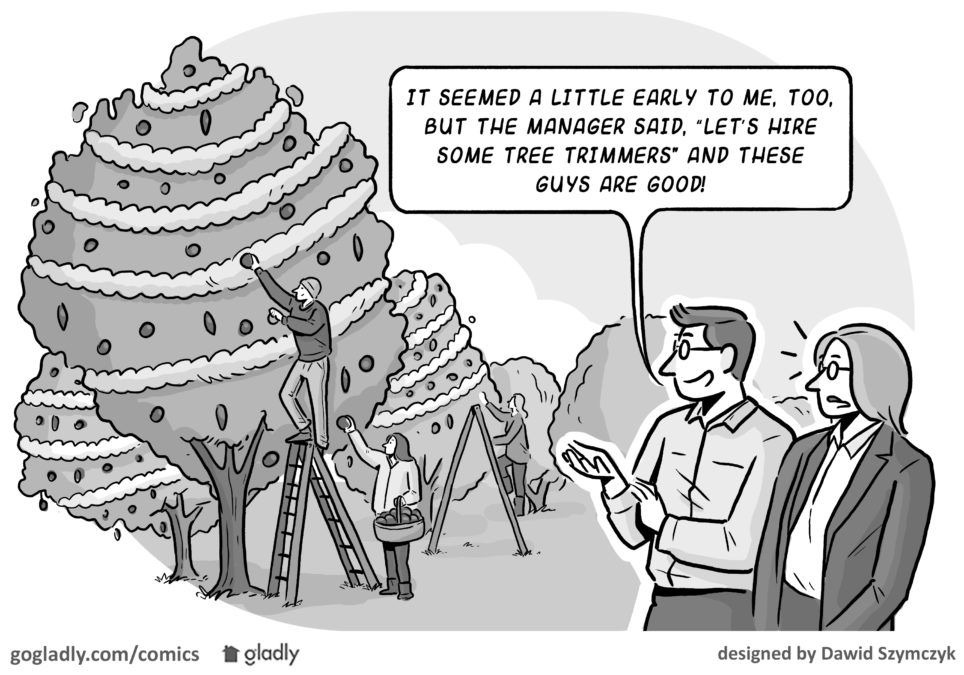Whether you’re the manager of a four-plex with 2 trees, or the on-site manager of a master planned community with 10,000 of them (yes, we have those in SoCal), you my friend are responsible for managing an urban forest (add that to your business card!).
An urban forest could best be described as a forest or collection of trees that grow within a city, town or suburb. In a wider sense, this could include any woody plant vegetation growing in and around single family, multi-family, or common interest housing developments. So if you’re a property manager, board member, or even a homeowner that belongs to an association, it’s important to learn some basic terms and principles of proper tree. Even if you’re not an arborist, that basic knowledge can help you manage your urban forest — so let’s get started.
Topping Trees
It might sound a bit like a holiday tradition, but what we arborists know as “topping trees” is actually a heinous practice. According to the International Society of Arboriculture (ISA), “topping is the indiscriminate cutting back of tree branches to stubs or lateral branches that are not large enough to assume the terminal role. Other names for topping include ‘heading,’ ‘tipping,’ ‘hat-racking,’ and ’rounding over’.” Not only does the practice of topping violate nationally accepted standards for proper pruning, but it seriously injures trees.
A few of the problems caused by topping include:
- Starvation: Topping removes so much of the crown of the tree that it upsets an older tree’s well-developed crown-to-root ratio, temporarily cutting off its food-making ability. The tree goes into shock and readily produces new shoots — both of which most communities and homeowners probably don’t appreciate.
- Weak & rapid new growth: The new shoots sprout out very quickly, but are poorly attached and far more numerous than if the tree hadn’t been topped. Now you have a potential population problem on your hands.
- Insects & disease: The large stems that are cut during topping have a difficult time healing over, and are more subject to insect infestation, airborne pathogens, and rot from standing water. Diseased trees not only look bad, but end up costing associations time and money — which brings up the next point.
- Increased maintenance and cost: A topped tree will cost more to maintain on an annual basis than a tree that has been properly maintained. Topped trees usually have extra leaf drop from excessive growth — creating more work for you. Plus, you face an increased risk of having to remove the tree in a few years due to wood rot and disease.
Well, now that we have touched on why topping is bad for trees — and communities — let’s look at what is good and healthy for the trees in your urban forest.
Pruning for Proper Performance
- Crown cleaning: Crown cleaning consists of the removal of dead, dying, broken, diseased, low vigor, and competing branches and water sprouts. Most pruning of mature trees falls into this category. A majority of the time, this is what I prescribe when I am doing an assessment for a property manager. When pruning trees this way, you don’t want to remove more than 25% of the total vegetation of the tree. In fact, for some Oak species where I live (Southern California), I recommend removing a maximum of only 10%.
- Crown reduction: Crown reduction is a pruning technique that removes weight from the end of branches back to a healthy, growing lateral branch, which will form a new crown. The process reduces long, heavy, or overextended branches, as well as removing any branches with significant defects. This is preferable to tree topping as it does not create the long term poor effects from topping a tree. And we still maintain that same 20-25% max of a trees total canopy be removed.
Removal
Sometimes it does become necessary to remove a tree, but how can you tell? Here are some reasons why an arborist might recommend removing a tree from your urban forest.
- The tree is in a state of decline, with more dead vegetation in the canopy than live vegetation.
- The tree leans excessively over buildings or high traffic areas.
- There is excessive rot / fruiting bodies at the base of a tree. A fruiting body — like a conk or mushroom — is the fruit of a fungus that has been at work in the host for several years.
As an arborist, I ask myself 2 questions when considering a tree for removal. First, what is the possibility of this tree failing? Second, what are the consequences of this tree failing? A tree located on a back slope with no foot traffic is much different than a tree that leans over a building or a playground. This list is by no means exhaustive, but is a good starting point to help your managed community make a better informed decision on caring for your urban forest.
Consider Working With a Tree Specialist
If you’ve got trees, you’ve got an urban forest. It’s always best to work with an arborist to ensure the health of your trees. Here are a few things to ask about when choosing a tree care provider:
- Is there a Certified Arborist on staff?
- Do they have the proper general liability & workers’ compensation coverage?
- Do they possess the right contractor’s license with special licensing for tree care?
- Do their employees all wear the correct P.P.E (personal protective equipment) at all times, and are there proper warning signs and cones set up on your property when trees are being maintained?
Many people in any kind of community tend to take trees for granted. Rather than leaving them alone and hoping for the best, focus on actively maintaining the trees on your property. Maintaining your urban forest is imperative to the beauty, safety, and livability of your community.
- Don’t Just Trim the Trees — Managing Your HOA’s Urban Forest - September 18, 2019



 Help
Help
Matt’s the Baum, he is so knowledgeable. California arbor care is doing my HOA trees in Downey this season and I’m sure it’s going to be a great job. The landscape part of their company is the Baum as well and they just got done doing slope clearance at my HOA in Whittier and the board was very impressed and the price was fantastic.
Thank you Faith, sure appreciate you and your friendship!